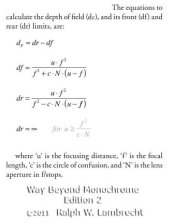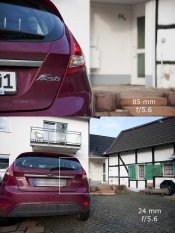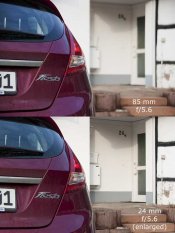tkamiya
Member
I'm confused about DOF when different image size AND equivalent focal length is concerned. I'd like to confirm my understanding.
As a multi-format shooter, this is important to me.
Let's say I have a 35mm film format camera with 50mm lens.
Let's say I have a 645 film camera with 80mm lens.
They are said to be about the same when it comes to viewing angles - correct?
If I set an aperture to f/2.8 for example, I will have LESS DOF on 645 camera than 35mm camera. At least that's true according to online DOF calculator at www.dofmaster.com
So... to generalize this, for equivalent focal length lens between different image size cameras, larger the image size, tighter DOF for a given aperture size. I have MORE control over DOF (ie. being able to obtain narrower DOF) on MF cameras than 35mm cameras.
Going extreme, if I have a pocket digi cam (sorry guys) with a tiny sensor, even if I go down to f/2.8 (if I could), I have a huge DOF that it is virtually impossible to have anything defocused.
If I have a 8x10 for example, LF camera, if I wanted to keep everything in focus, I really have to stop down to f/64 or something.
Am I correct on this?
Please keep this discussion simple. Please try not to add to my confusion. I really want to understand this.... if someone wants to discuss fine details on this, please start your own thread.
Thanks!
As a multi-format shooter, this is important to me.
Let's say I have a 35mm film format camera with 50mm lens.
Let's say I have a 645 film camera with 80mm lens.
They are said to be about the same when it comes to viewing angles - correct?
If I set an aperture to f/2.8 for example, I will have LESS DOF on 645 camera than 35mm camera. At least that's true according to online DOF calculator at www.dofmaster.com
So... to generalize this, for equivalent focal length lens between different image size cameras, larger the image size, tighter DOF for a given aperture size. I have MORE control over DOF (ie. being able to obtain narrower DOF) on MF cameras than 35mm cameras.
Going extreme, if I have a pocket digi cam (sorry guys) with a tiny sensor, even if I go down to f/2.8 (if I could), I have a huge DOF that it is virtually impossible to have anything defocused.
If I have a 8x10 for example, LF camera, if I wanted to keep everything in focus, I really have to stop down to f/64 or something.
Am I correct on this?
Please keep this discussion simple. Please try not to add to my confusion. I really want to understand this.... if someone wants to discuss fine details on this, please start your own thread.
Thanks!









